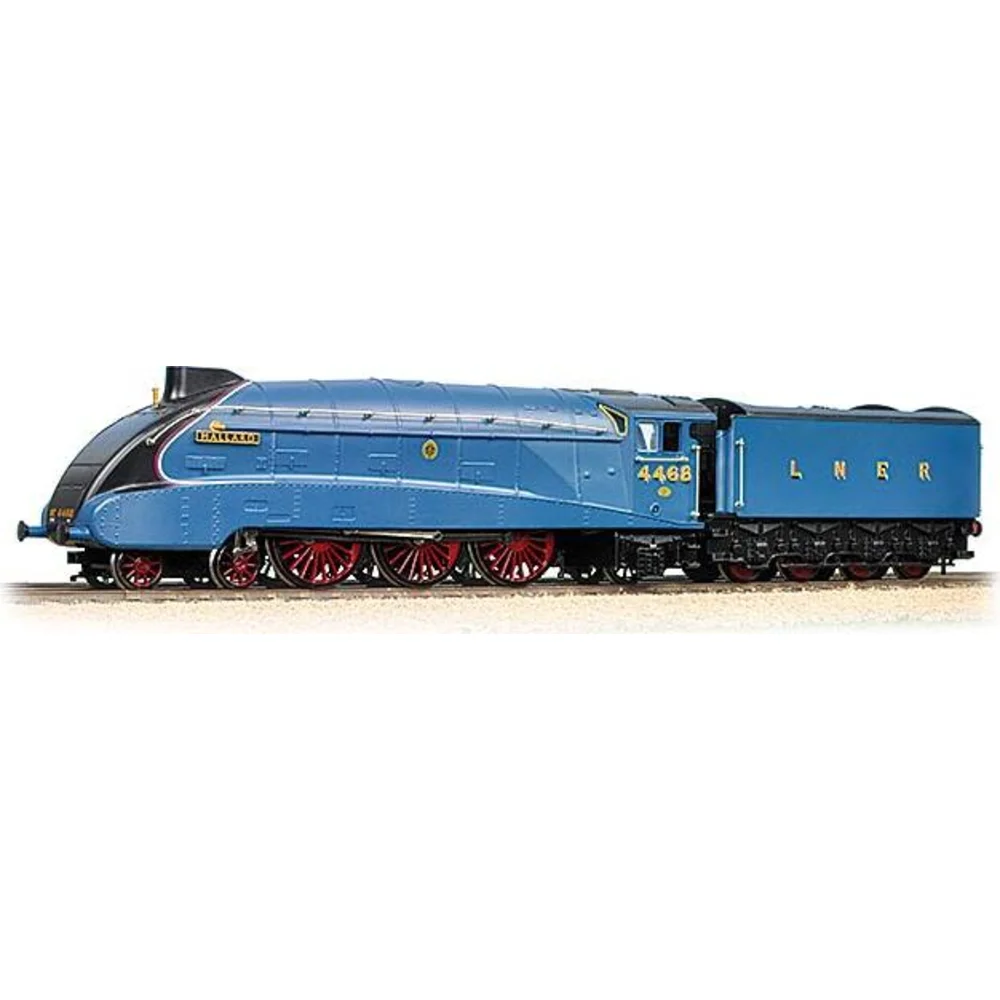Bachmann 31-952B
London & North Eastern Railway A4 4468 "Mallard" London & North Eastern Railway Garter Blue
Tooling
In 2011, Bachmann Branchline introduced a major upgrade to its long-standing A4 Pacific tooling. This retool replaced the older split-chassis design from 1995 with a modern mechanism and improved detailing, bringing the model up to contemporary standards. The upgrade was part of Bachmann’s broader program to modernize key LNER classes, ensuring competitive performance and finish against Hornby’s super-detailed A4 range.
Tooling Features
- Scale: OO gauge (1:76).
- Construction: Plastic bodyshell with separately fitted details; chassis combines metal and plastic for strength and weight.
- Detailing: Factory-fitted handrails, lamp irons, safety valves, whistles, bufferbeam detail, and pipework. Sprung buffers and chemically blackened wheels add realism. Cab glazing and painted cab interior included.
- Couplings: NEM pockets with tension-lock couplers; cosmetic screw-link couplings supplied for display.
Mechanical & Electrical
- Motor & Drive: Smooth-running 5-pole motor located in the locomotive, driving the main driving wheels.
- Chassis: Modern solid-frame design with all-wheel pickup for reliable performance.
- Minimum Radius: Designed for second radius curves (approx. 438 mm).
- Lighting: No factory lighting provision.
- Weighting: Metal components within chassis and tender for improved adhesion.
- Power Collection: 2-rail DC.
DCC Capability
The 2011 tooling is DCC Ready with an 8-pin socket located in the locomotive. Provision for a 28mm round speaker is included for sound installation, although sound was not factory-fitted.
Liveries Produced
The retooled A4 has been released in a variety of authentic schemes, including:
- LNER Garter Blue (with and without valances)
- LNER Silver Grey (“Silver Jubilee”)
- BR Express Passenger Blue
- BR Green (early and late crests)
- Special editions for preserved locomotives such as Mallard, Sir Nigel Gresley, Union of South Africa, Dominion of Canada, and Dwight D. Eisenhower.
Performance & Reviews
The upgrade was widely praised for its smooth, quiet running and improved slow-speed control compared to the older split-chassis design. Reviewers noted the model’s excellent finish and robust mechanism, though some commented that body mouldings were less refined than Hornby’s equivalent. Enthusiasts appreciated the ease of DCC fitting and the inclusion of sprung buffers and NEM couplers. Haulage capacity was considered adequate for typical express passenger trains.
Media & Community Commentary
The 2011 A4 tooling received positive coverage in model railway magazines and online forums. Video reviews on platforms like YouTube highlight its reliable performance and improved detailing. Social media discussions often compare it favorably to Hornby’s A4, citing availability and consistent quality as strong points.
Interesting Notes
- The upgrade marked the end of Bachmann’s split-chassis era for steam models.
- Accessory packs included additional detail parts for customization.
- Special commemorative releases coincided with events such as the “Great Gathering” of preserved A4 locomotives in 2013.
Class & Prototype
- Class: London & North Eastern Railway A4
- Traction: Steam
- Built: 1935-1938
- Total Built: 35
- Running Number: 4468
- Name: Mallard
- Ordered By: London & North Eastern Railway
- Built By: London & North Eastern Railway
- Built At: Doncaster
- Built: 03/1938
- Withdrawn: 04/1963
- Length of Service: 25.1 years
- Running Numbers: LNER 4468, LNER 22, BR 60022
- Names: Mallard
Operator & Livery
- Operator: London & North Eastern Railway
- Livery: Garter Blue
The London & North Eastern Railway emerged in 1923 as Britain's second-largest railway company, combining seven major railways including the Great Northern, North Eastern, and Great Eastern into a 6,590-mile network stretching from London's four terminals to the Scottish Highlands. Despite serving economically challenged industrial regions, the LNER achieved worldwide recognition for engineering excellence and speed records that remain unbroken today.
Under Chief Mechanical Engineers Sir Nigel Gresley, Edward Thompson, and Arthur Peppercorn, the LNER developed revolutionary locomotive designs characterised by three-cylinder layouts and streamlined aesthetics. Gresley's masterpieces included the A1 Pacifics featuring Flying Scotsman and the legendary A4 class, culminating in Mallard's world steam speed record of 126 mph in 1938.
The company pioneered luxury express services including the Silver Jubilee and Coronation streamliners, whilst investing in forward-thinking electrification schemes and massive marshalling yards. Notable achievements included operating the complete East Coast Main Line, introducing Britain's first regular 400-mile non-stop service, and commissioning Eric Gill's iconic typography that influenced railway design for decades.
Nationalised in 1948, LNER locomotives continued serving British Railways until the 1960s, with some A4 Pacifics working Scottish expresses until 1966. Today, the LNER's engineering legacy thrives through extensive preservation, new-build projects like Tornado, and comprehensive model ranges covering every major class in all popular scales, making LNER subjects essential for discerning railway modellers seeking authentic British steam-age atmosphere.
